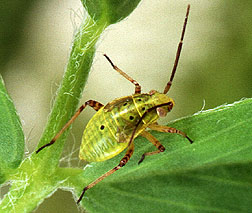This page has been archived and is being provided for reference purposes only. The page is no longer being updated, and therefore, links on the page may be invalid.
ARS Survey Helps Growers Track Two Key Cotton Pests
By Dennis O'BrienNovember 30, 2009
Cotton growers will be better able to keep an eye out for two common pests because of a comprehensive survey by Agricultural Research Service (ARS) scientists at College Station, Texas.
Entomologist Jesus Esquivel, at the ARS Southern Plains Agricultural Research Center in College Station, collected insects from fields and roadsides bordering cotton crops to identify plants that host tarnished plant bugs and cotton fleahoppers. Both of these insects cause major damage when they jump from weeds to developing cotton each spring.
The tarnished plant bug infested 4.8 million acres of U.S. cotton in 2008, making it the single most damaging insect for domestic cotton. The fleahopper ranked fifth, infesting 2.3 million acres.
Growers traditionally sprayed for boll weevils, and these insecticide sprays also helped control the tarnished plant bug and the cotton fleahopper. But successful eradication efforts to control boll weevils, the increasing use of Bt cotton, and more target-specific insecticides have reduced the need for spraying and raised concerns about keeping fleahoppers, tarnished plant bugs and other cotton pest insects in check.
Adult tarnished plant bugs spend winters in ground litter and emerge in spring to feed on wild plants. They infest developing cotton buds, damage bolls and are believed to transmit cotton diseases. Cotton fleahoppers emerge from eggs in the spring and feed on weeds before moving to cotton in May and early June. Cotton fleahoppers have reportedly infested cotton located 20 miles from their weed hosts.
Esquivel sampled more than 80 sites at least twice a week for three years in the spring, summer, fall and winter, collecting insects from soybean and alfalfa fields and from weed-infested plots. He gathered plant samples and insects in nets, stored them in sealed plastic bags, and identified them under microscopes.
Most significant host plants had been previously identified. But he found 13 previously unreported hosts for tarnished plant bugs and 8 previously unreported hosts for fleahoppers. All are weeds commonly found in Central Texas.
The tarnished plant bug and fleahopper findings, published separately in Environmental Entomology, will add to growers' awareness about conditions that contribute to infestations and crop losses.
ARS is the principal intramural scientific research agency of the U.S. Department of Agriculture.

